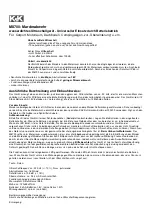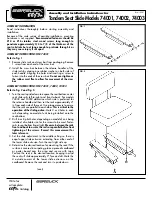
TECHNICAL NOTICE
I’D L
D0000800A (010616)
5
8
8B. Work positioning - secured stop
After stopping at the desired location, to switch to the
hands-free work positioning mode, lock the device on
the rope by moving the handle in the direction opposite
to that used for descent (turned to position b). For work
positioning, the I’D must be set in this position.
Once the handle has stopped at position b (positioning),
do not force the handle. The handle must not be in position
a (transport) with a rope in the device. There is a risk of
damaging the device, which can negate the braking function.
To unlock the system, firmly grip the brake side of the rope
and move the handle into descent position.
Information on the EN 12841 standard
WARNING: the I’D L descender must be used in
conjunction with a type A backup device (e.g. the ASAP)
on a second rope (called the “safety rope”).
The I’D L descender is not suitable for use in an EN 363 fall
arrest system.
Attach your descender directly to the harness using an
EN 362 locking carabiner. Any equipment used with your
descender must be in compliance with current standards.
When you are under tension on the work rope, make sure
that the safety rope is not loaded.
A dynamic overload can damage the safety rope.
EN 12841: 2006 Type C
A
9
Maximum descent height: 200 m.
Normal working load: 30-150 kg.
Lowering from an anchor-point
Device on the anchor: the brake side of
the rope must be redirected through a
carabiner. Hold the brake side of the rope
and move the handle up (position c) to
allow the rope to slide. Braking is regulated
by varying the grip on the brake side of the
rope. Release the handle to activate the
self-braking function.
When the device is lightly loaded, if the
panic brake activates too easily, use the
horizontal movement button.
Information on the EN 341 standard
- Always tie a knot at the end of the rope.
- Equipment left in place must be protected
from the elements.
- Do not lose control during the descent;
descend at a reasonable speed.
- Warning: the device can overheat and
damage the rope during descent.
EN 341 class A (1997) Rescue evacuation
2 m/s
maxi
150 kg MAXIMUM
10
Belaying
10A. Belaying the leader: 100 kg
Use an EN 892-certified dynamic rope.
Device on the harness (position e): before use, verify the rope is correctly installed. The
brake side of the rope is held in one hand and the climber side in the other. To facilitate rope
glide, focus more on pushing the brake side of the rope into the device rather than pulling
the climber side of the rope. To stop a fall, firmly grip the brake side of the rope. To lower a
climber, the manipulation of the device is similar to the description found under Descent.
10B. Belaying: 100
kg
Belaying a second, and
hauling (usage without
redirecting the rope
through a carabiner).
Warning: in the event of
an error (rope installed
backwards), the anti-error
catch will not work in this
position.
Device on the anchor
(position e): the belayer
holds the brake side of the
rope with one hand, and
the second’s rope with
the other. Take in slack
regularly. To stop a fall,
firmly grip the brake side
of the rope. To lower a
climber, the manipulation
of the device is similar
to the description found
under Lowering from an
anchor (use a braking
carabiner).
Lifting line
100 kg MAXIMUM
100 kg MAXIMUM
Содержание I'D S
Страница 1: ...TECHNICAL NOTICE I D S D0000900A 010616 1...
Страница 2: ...TECHNICAL NOTICE I D S D0000900A 010616 2...
Страница 3: ...TECHNICAL NOTICE I D S D0000900A 010616 3...
Страница 4: ...TECHNICAL NOTICE I D S D0000900A 010616 4...































